Can you optimize your website all by yourself? Certainly, as your project grows, so does the need for the services of an SEO agency. Yet, people are often surprised to learn how much they can do on their own, equipped with robust knowledge and tools. For the purposes of this article, we will show and discuss the examples with the help of the Senuto app.
Data vs. intuition
For starters, one rule of thumb: SEO works best when it’s data-driven, not based on your general “feel”. Intuition may play a part as you make up a title for your new traffic-driving article. You know your readers, the industry, and the right topics to grab the spotlight. You can predict some trends or set new ones. In that case, your keyword selection will base partially on the suggestions of your inner voice.
For the rest part, SEO means working with data – which has its upsides and downsides.
The bad part is that you really need to learn data collection and interpretation. Some people may find it pretty dull – there’s lots of toying with charts, tables, and figures. Instead of letting your imagination run wild, you need to sit down, create a data-driven plan, and stick to it. Depending on your personal preference, it may be a minus, a matter of course, or even a delight.
The good part comes with time, when you actually see the first effects and your plan starts working. At this point, you notice that despite the relative unpredictability of SEO, it does follow some logical rules. There are many aspects you can purposely bring under control. If you give it enough time and energy, SEO increases your profits. Or let me rephrase that: SEO improves your Google visibility, which attracts more visitors – and brings better profits.
I won’t lay out here all the rules and relations that come into play in SEO. However, I will show you which data to look out for and how to go about their interpretation. This alone should tell you a lot about handling all that SEO. In the best-case scenario, it will also inspire you to do your own research.
Generate the traffic you need
You don’t need just any traffic on your website – you need traffic that gets conversions. Keep that at the back of your mind, because too many people focus on perfecting their visit statistics without paying attention to the profile of the visitors.
Business-wise, only the “right” visitors will generate conversions by signing up for your newsletter, buying your product, subscribing to a paid service, and so on. All the others may work wonders for your Google Analytics statistics, but not necessarily for your bank account.
For this reason, stimulate traffic with the right keywords, because that’s what draws the right visitors. Keywords and customer profile are two sides of the same coin. If you have the right keywords, you will identify your customer. And if you have identified your customer, you can choose better keywords.
For a while, let’s focus on the customer.
Persona – the portrait of your customer
Let’s say that the “customer” is the person that you really want to reach when stimulating traffic. Maybe they’ll buy your product right away, maybe in a year. Or never – but they will leave positive comments on your content, inclining others to make a purchase. That’s the kind of people you need.
You should have an image of a person who exhibits your desired behavior: visits your site, interacts with it, and potentially leaves their money.
That image is called a persona. The process of building a persona is guided by many questions, such as:
- Demographic data: what is the gender and age of your ideal customer? How big a city do they inhabit (or maybe they live in the countryside)? What is their education? Do they have children?
- Where do they work (what industry, what position) and how much do they earn?
- What are their professional goals and ambitions?
- What are their pastimes and hobbies?
- What technologies and information sources do they use?
- What frustrates them? What life problems do they need solving?
- What is their ideal shopping experience?
Armed with this information, you can think up queries that such a persona is likely to type in Google Search.
These will include both short-tail keywords (such as “geforce graphics card”) and long-tail keywords (such as ““geforce gtx 1050 graphics card” or “best graphics card for gaming up to USD 100”).
Are you starting to see how the persona drives the selection of your targeted keywords, and by extension – how it shapes your entire SEO strategy?
Customer journey – from start to finish
Let’s add one more element to the mix: the customer journey. You may be familiar with that idea. In brief, a user looking to satisfy a need may be at different stages of their research.
Think back to a moment when you wanted to upgrade your computer graphics, take up running, or buy a gift.
In many cases, you knew nothing or next to nothing at the start. Therefore, your first step was to learn. You obtained more information. In time, you pinpointed a few ideas and/or products. You weighed the pros and cons, compared parameters and prices, read reviews.
Finally, you selected your service or product provider. Lo and behold, you became a customer, a subscriber, a regular reader – or all of the above.
At each and every stage, you searched the internet for different keywords, looking for different information. The websites which met your needs at one step of the search have won you as a visitor. Plus one to their statistics.
If one of them provided you with answers to all your questions and offered the product at a good price, the quest was over – you satisfied your consumer need, the business got its money… and maybe a regular client. Win-win.
Let’s imagine your journey across Google. It may have looked something like that:
“best gift for Father’s Day”. You enter your query and get a list of websites inviting you to read their suggestions. You decide to go for an electric shaver. Or maybe a trimmer? What is the difference, really? So you type…
“electric shaver or trimmer which is best”. Guides, guides, guides. One of them informs you of the existence of full-body shavers for men. Perfect. So you type…
“body shaver for men”. Now, product pages crop up. Some models catch your eye. So you type…
“XXX shaver test”, and in the next tabs: “YYY shaver test” and “ZZZ shaver test”. You read up, see photos, compare, and make your choice. Dad will be happy.
If you own an online store offering shavers and trimmers, that imagined customer journey should provide you with some keyword ideas. That’s one step of your SEO strategy building. No reason to skip it. But for the strategy to really hold water and suit your type of business, you need more.
Common sense, the imagined persona, and their customer journey need backing in data.
Intuition is fallible, and data imbues you with a greater sense of control and direction. Data can give you a precise understanding of where you stand – which constitutes a foundation for your future plans. Besides, as you are using data collection tools, you may fish up ideas that would never just pop into your head.
Keyword research in Senuto
A good way to check what your customers are searching in Google is to use Keyword Research available in the Senuto app. Enter “shaver” to see what piques the interest of your customers in the context of shavers:
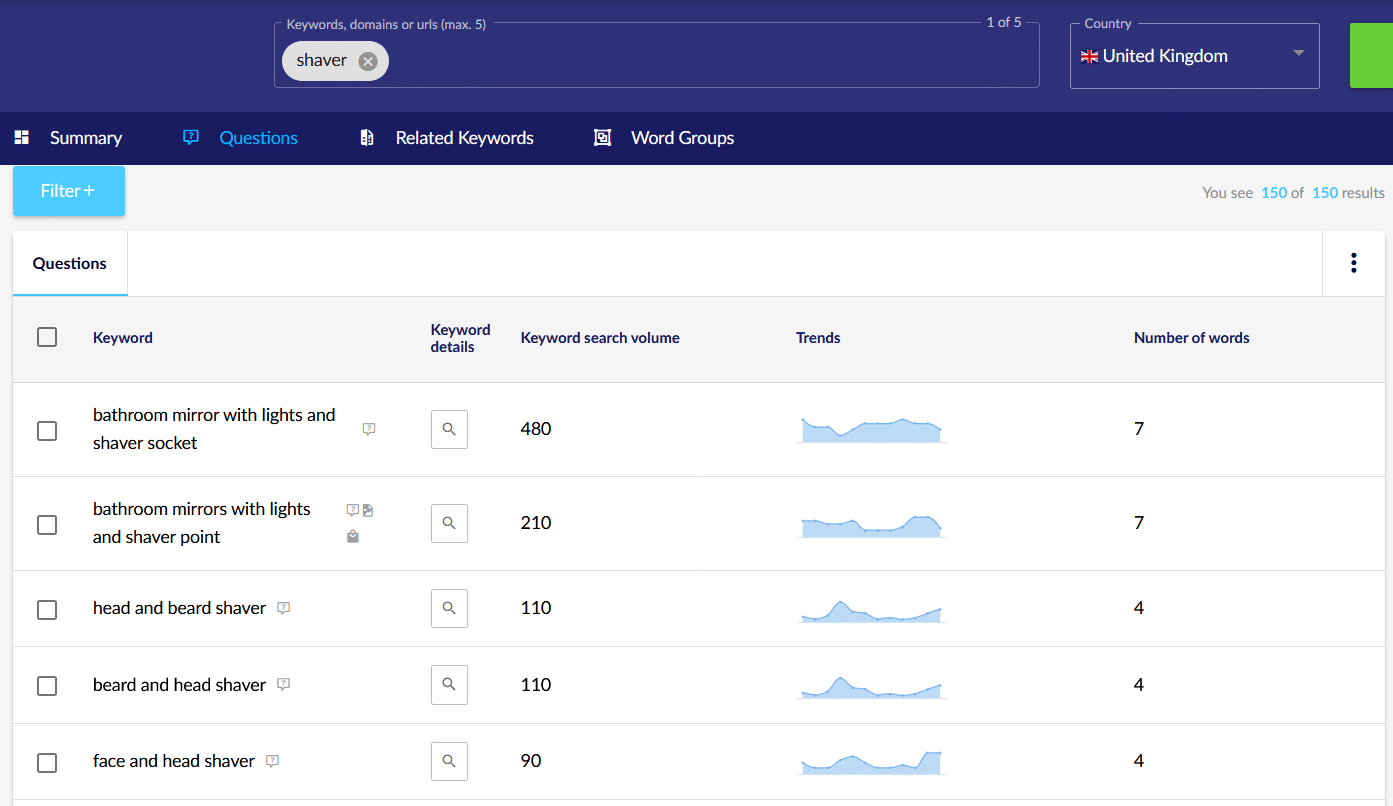
An average monthly number of searches points to the popularity of the query.
For instance, you can see that the phrase “face and head shaver” is not commonly asked in Google. But watch out: it is often the keywords with a relatively low average number of searches that prove worth targeting.
Why? Because in principle, with greater popularity comes greater competition. And the more general the keyword – think “head shaver” or “shaver for bald head” – the greater its popularity.
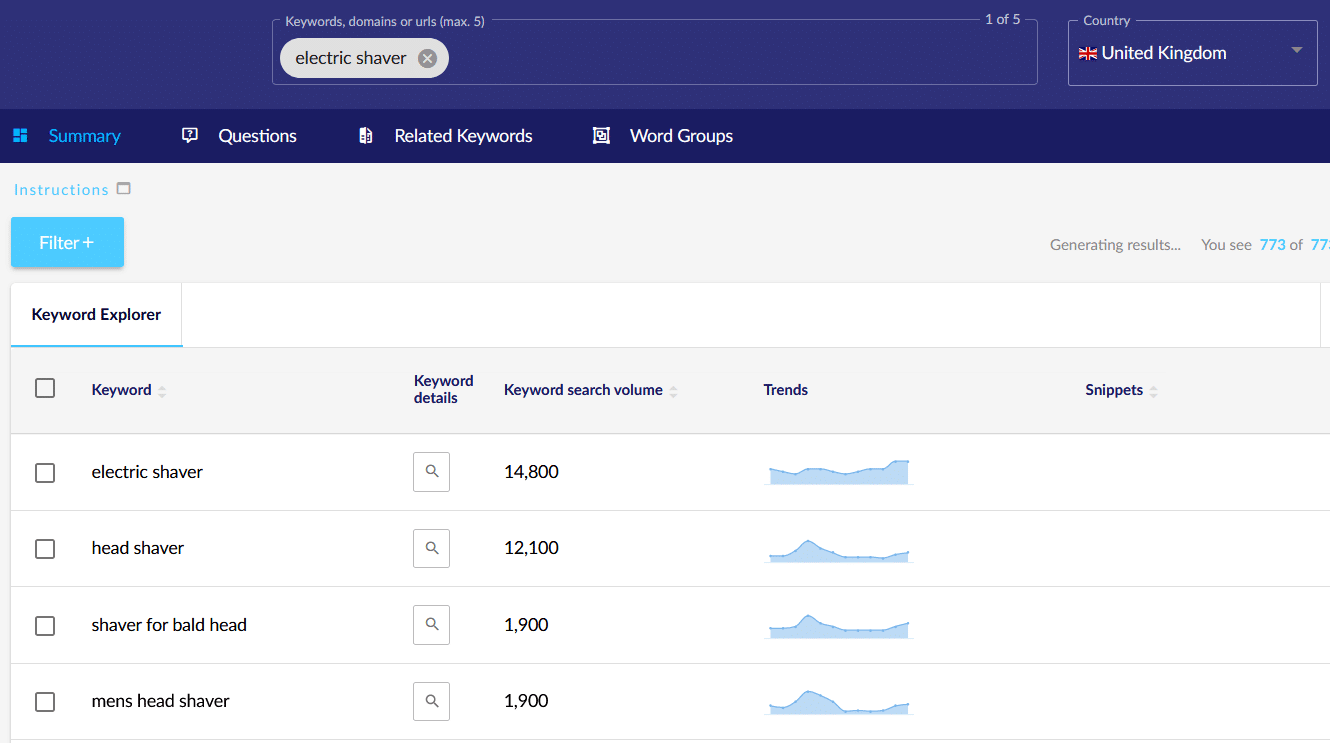
Click on the details of the “electric shaver” keyword (magnifying glass icon) to see – among other data – its SERP analysis, that is 20 top-ranking websites displayed for this keyword.
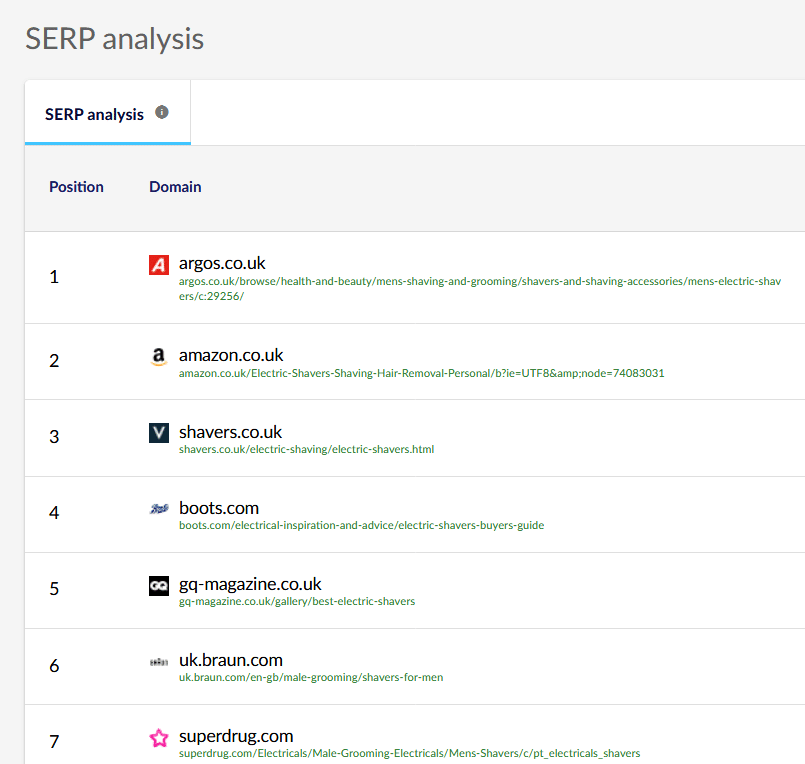
As you can see, top listings are the stronghold of some really major players. Can you compete with them? Sure you can – with the right amount of time and money, that is. And in this case, the right amount would be a lot, on both counts.
For many businesses, getting through to top Google ranks for general and highly popular keywords remains a merely theoretical possibility.
In practice, it’s better to focus on long-tail keywords, which are more precise and less frequently entered in Google Search. They may have a lower search volume, but people who type them are more aware of what they want. When dealing with this type of users, it’s generally easier to find something you can offer.
That is how you exploit data to adapt your SEO strategy to your budget and opportunities. You get a grasp of your Google situation, investigate your competition, and look for niches to fill.
Besides, check your keywords for seasonal trends. Some keywords are popular in Google in particular months only. “Garden furniture” may hit the spot in July, and “New Year’s Eve venues” – in December. The opposite is unlikely. Thinking about trends is particularly useful as you create:
- a long-term content schedule for a blog,
- a marketing strategy for a company,
- a product offer for an online store.

This is how you check keyword popularity in a given month.
You can also use Google Trends to see which months are “dead” and which present an opportunity for more traffic:
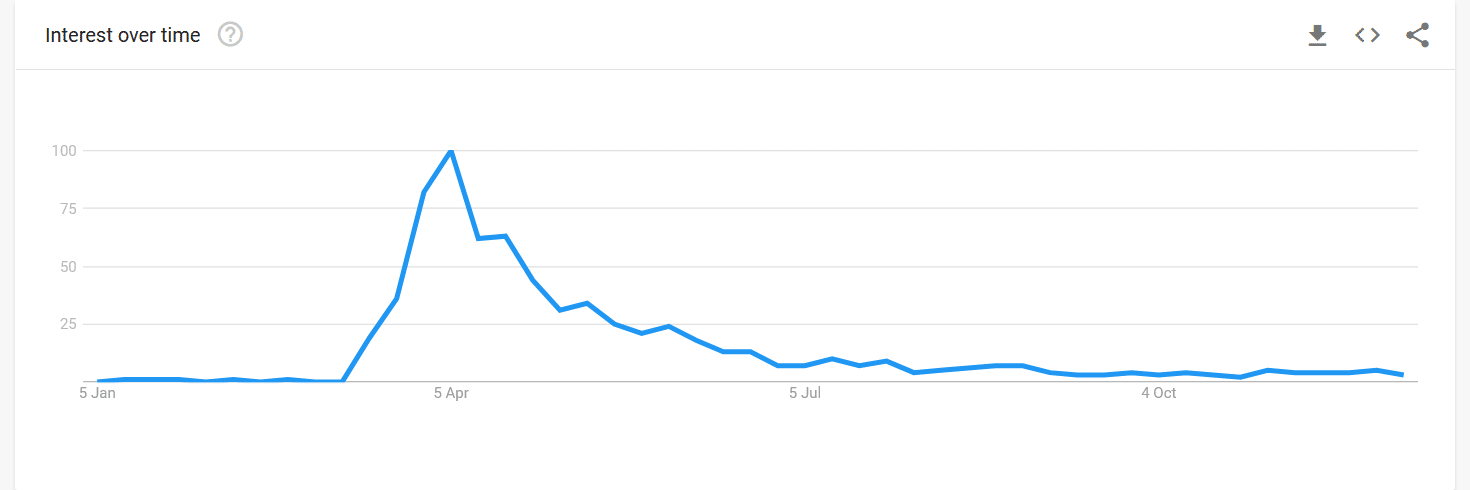
On an extra note, it’s good to check website seasonality. The Senuto chart uses your current keyword ranks to predict the potential traffic for each month:

Seasonal trends and keywords are broad topics. Surely, it’s a good idea to do some more research to get a deeper understanding of both. To quote Milena Fietko, Senior SEO Specialist at Delante:
“The key to success – for an entrepreneur and an SEO agency alike – is not to wake up at the last minute before the high season and grasp at short-term solutions, but to knowingly plan and consistently implement actions that will bear fruits for the whole year”.
How much are Google ranks worth?
High Google ranks are not an end in themselves, but a key to achieving your sales targets. If you invest time and/or money in your SEO, it’s a good call to create an estimated return rate. To do that, you need to know the so-called CTR (click-through ratio) for your listings in search results. CTR is the rate of clicks to impressions. If 1000 people saw the listing and 100 clicked, CTR is at 10%.
Senuto conducted a study to examine the CTR of top-ranking listings in Google (excluding brand keywords such as “nike” or “philips”).
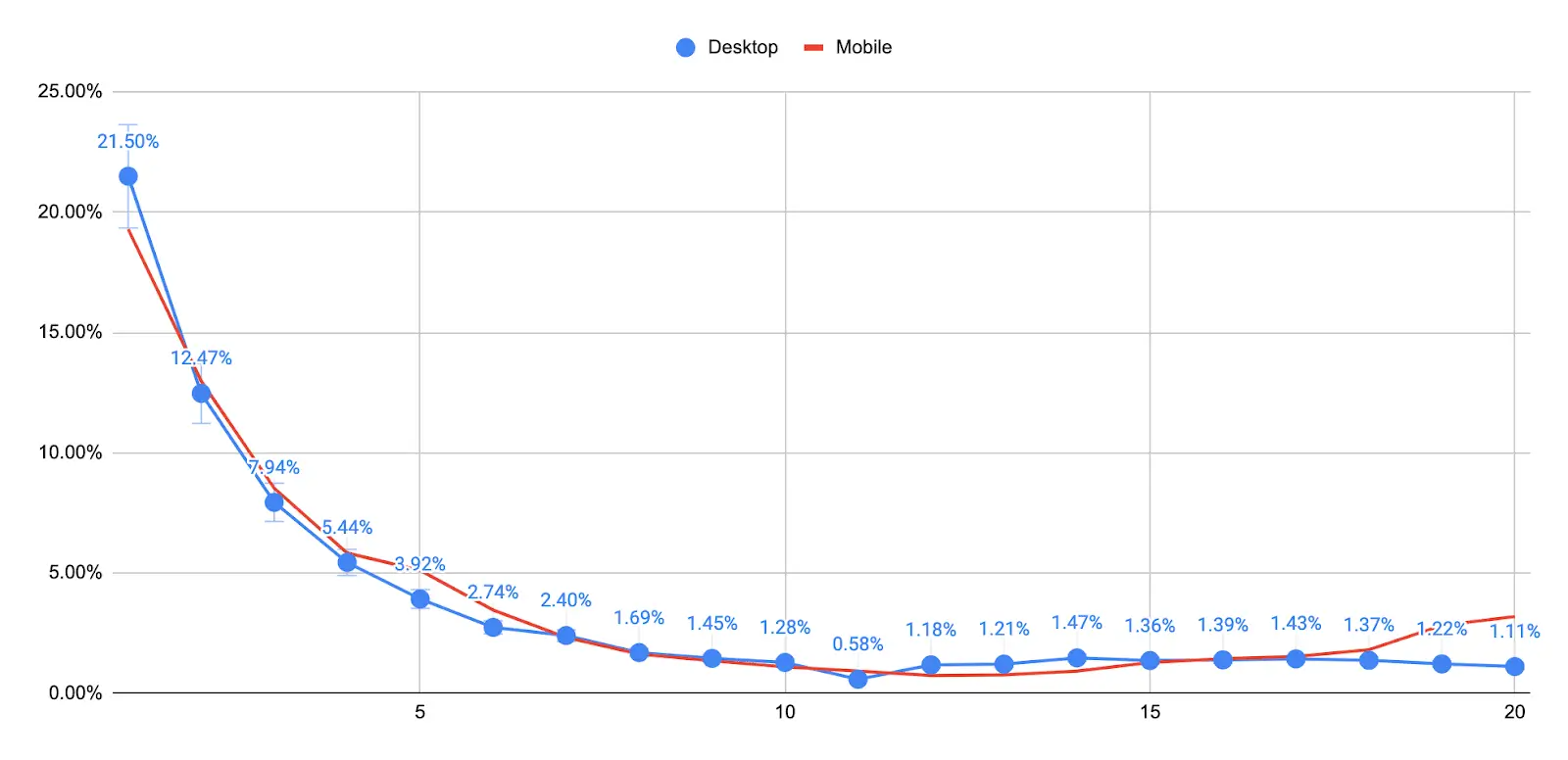
In table format:
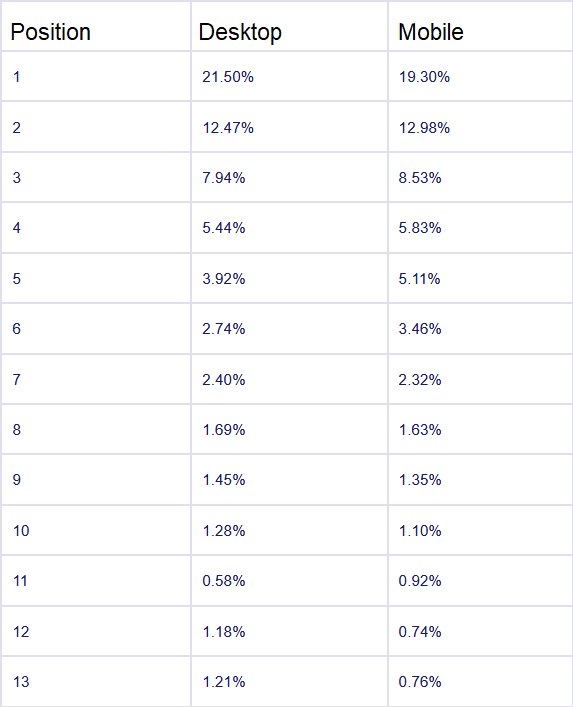
Clearly, top listings in Google Search get the lion share of the clicks. As you look further down, the number of clicks gets lower – the bottom-page results (10th rank) usually have CTR at the level of 1%.
Let’s say that you want to use your website for selling an online course on staff motivation in various organisations. The query “how to motivate a teamyour employees” gets around 720 monthly searches, as you can see on a screen from Keyword Explorer:
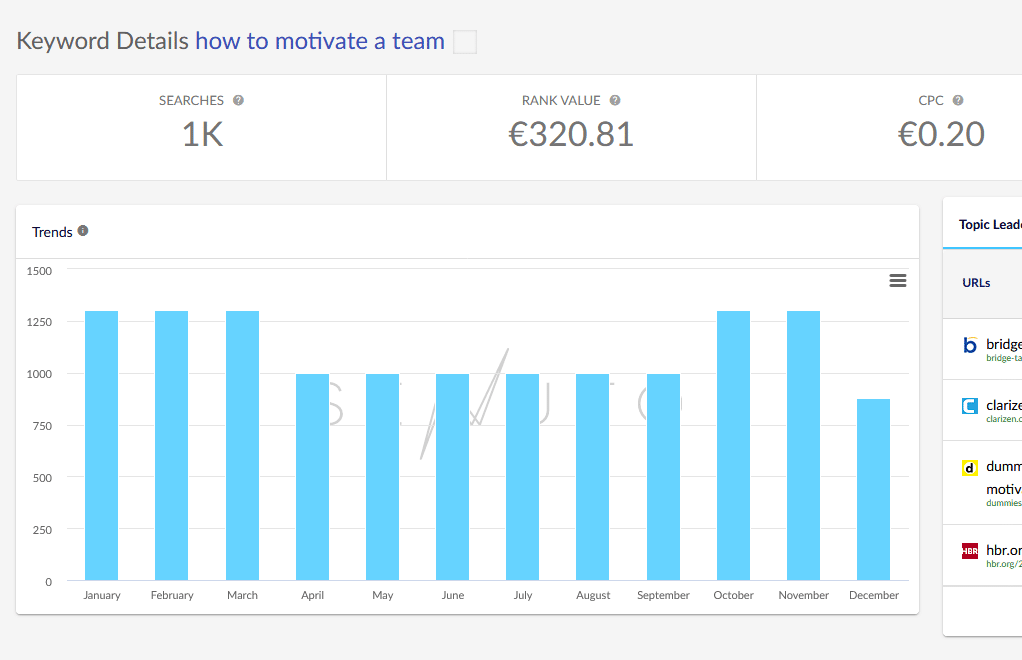
The percentage of people who click on your listing upon entering this keyword in Google depends on your rank (estimates based on data for desktop devices):
1st rank: 720 x 21.5% = 215 visits per month, 2580 per year.
2nd rank: 720 x 12.47% = 125 visits per month, 1500 per year.
3rd rank: 720 x 7.94% = 79 visits per month, 948 per year.
And so on.
Keep in mind that if you rank high for the keyword “how to motivate a team”, usually you will be it will be relatively easy to become visible also in searches for related phrases such as “employee motivation” (590 monthly searches on average) or “motivation techniques” (480). The traffic will cumulate. Getting ahead of your competition may not be easy, but it is possible. In the long run, you may count on highly satisfactory organic traffic on your website.
You may ask how much money you’ll make on that.
The answer depends on various factors that you can work on, including the quality of your website, your competitiveness, and the framing of your offer. If 10.000 people get to your site and 3% of them will buy your product, you will sell 300 courses. If your profit on a single course is USD 100, you may say that your high Google ranks earned you a yearly profit at the level of USD 30.000. And that’s not all. After all, people will continue to search Google for employee motivators in the next year, too.
Compare your estimated SEO costs against profits to see whether the campaign pays off.
What else to consider as you plan and monitor your SEO campaign
I have provided the examples above to show you how working with data may give your plans a clearer form and shape. It is not a full guide on planning your SEO activity. That would require writing a whole ebook. However, let’s mention several other factors to consider when discussing your Google ranks.
Visibility analysis, or what your website looks like in Google
It’s not only about you, but about your competition as well.
As sailors put it: “To know where you’re going, you need to know where you come from”. Or was that a quote from “Lord of the Rings”? Anyways, knowing the ranks that you and your rivals occupy for your target keywords will give you a better grasp of where you stand – and an anchor for planning future actions.
Visibility Analysis in Senuto will present you Google visibility of almost any website (out of a few million domains included in the database) and allow you to effortlessly check:
- Common keywords – keywords that you and your competitor are ranking for,
- Keywords unique to competitor – keywords your competitor is ranking for, and you do not,
- Keywords unique to your website – keywords you are ranking for, and your competitor is not.
For instance, these are the common keywords of lidl.pl and carrefour.pl:
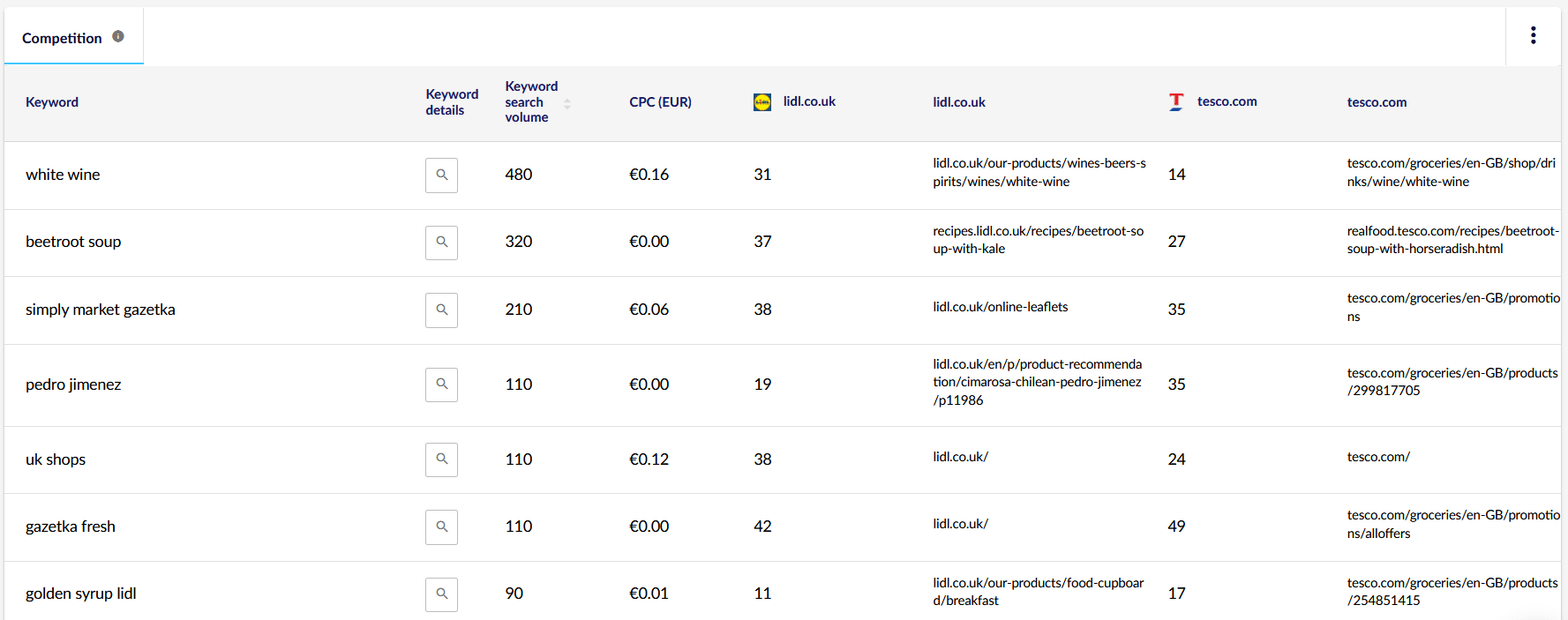
Of course, these data may change over time. Sometimes you go up, and sometimes you go down – and so do your competitors. With that in mind, it’s a good idea to check the ranks of your website and your rivals once in a while.
Quick wins
One more interesting trick to use when planning your SEO campaign concerns the so-called quick wins. The idea is to check for which keywords your listing ranks 11th–20th and gets displayed on Page Two of the SERPs.
These listings probably generate zero or trace amounts of traffic – hardly anybody clicks through to the second page. At the same time, with just a little work, they will climb right to the first page, driving new people to your site. It’s a good call to target these keywords in your SEO strategy. Big wins at low cost await.
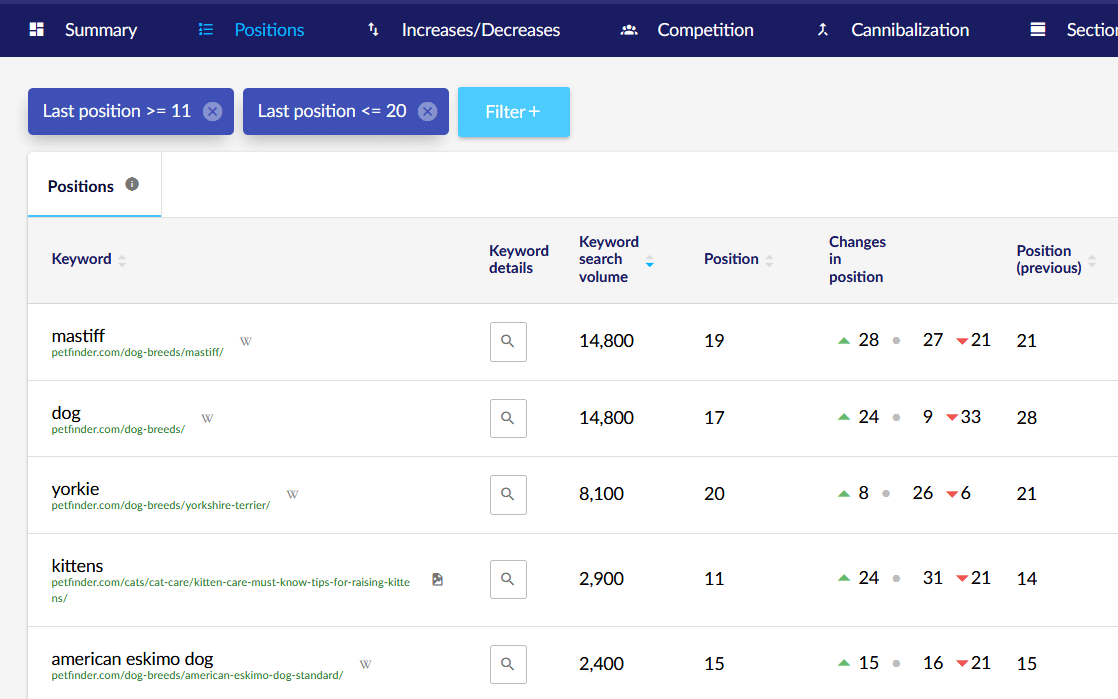
One example of quick wins: petfinder.com. The keyword (kittens) ranks 11th – just off Page One. And it has an average of 2900 monthly searches! Use it as a point of focus in your SEO strategy and track your progress.
Progress tracking
To know whether your SEO activity is working, you must observe progress over time. For how many keywords is my site ranking in TOP 3 today? For how many is it ranking in TOP 10 and TOP 50?
Unfortunately, the free-of-charge Google Analytics tool will not give you answers to these questions – although it is a useful tool for examining the sources of traffic and the demographic information of your visitors – but you can yet again turn to Senuto.
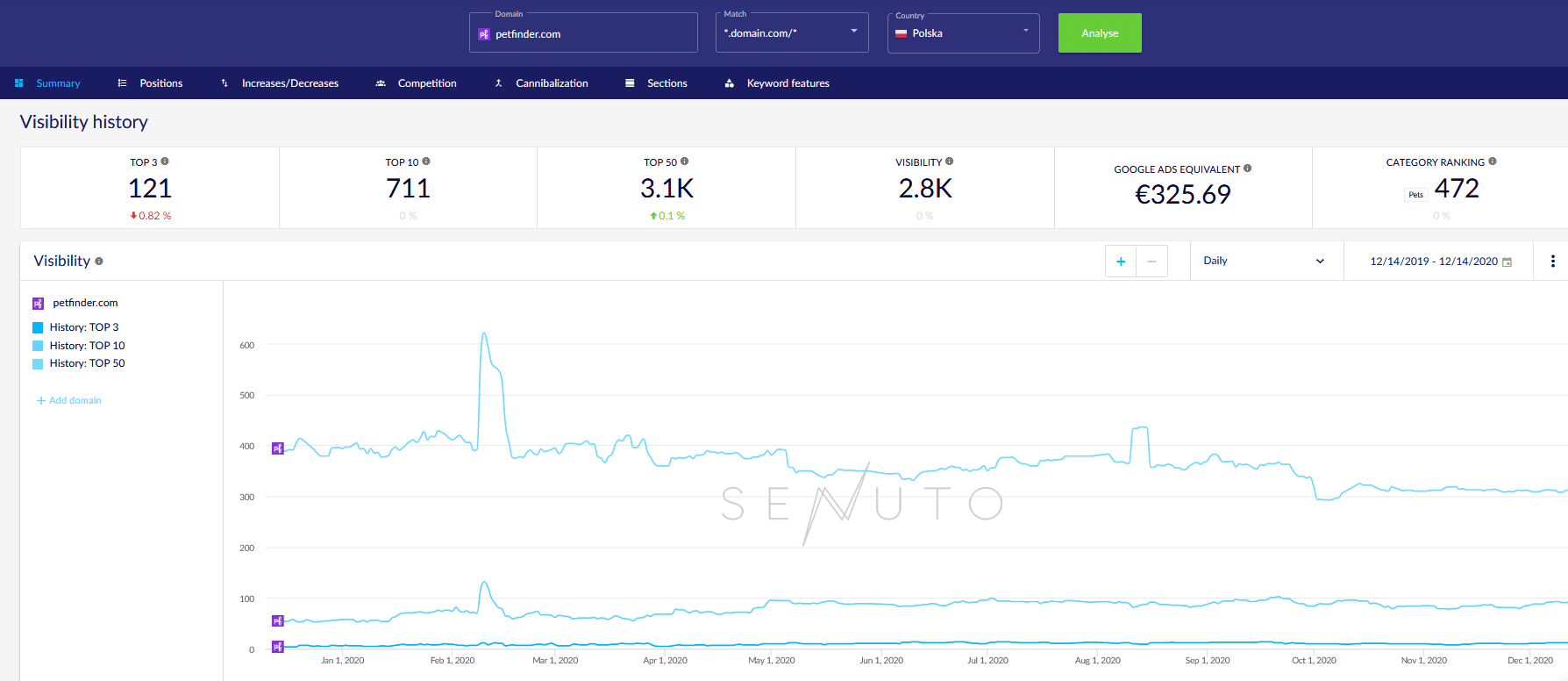
Quarterly shifts in the visibility of petfinder.com, with the consideration of positions in TOP 3, TOP 10, and TOP 50, and a table listing all the relevant keywords:
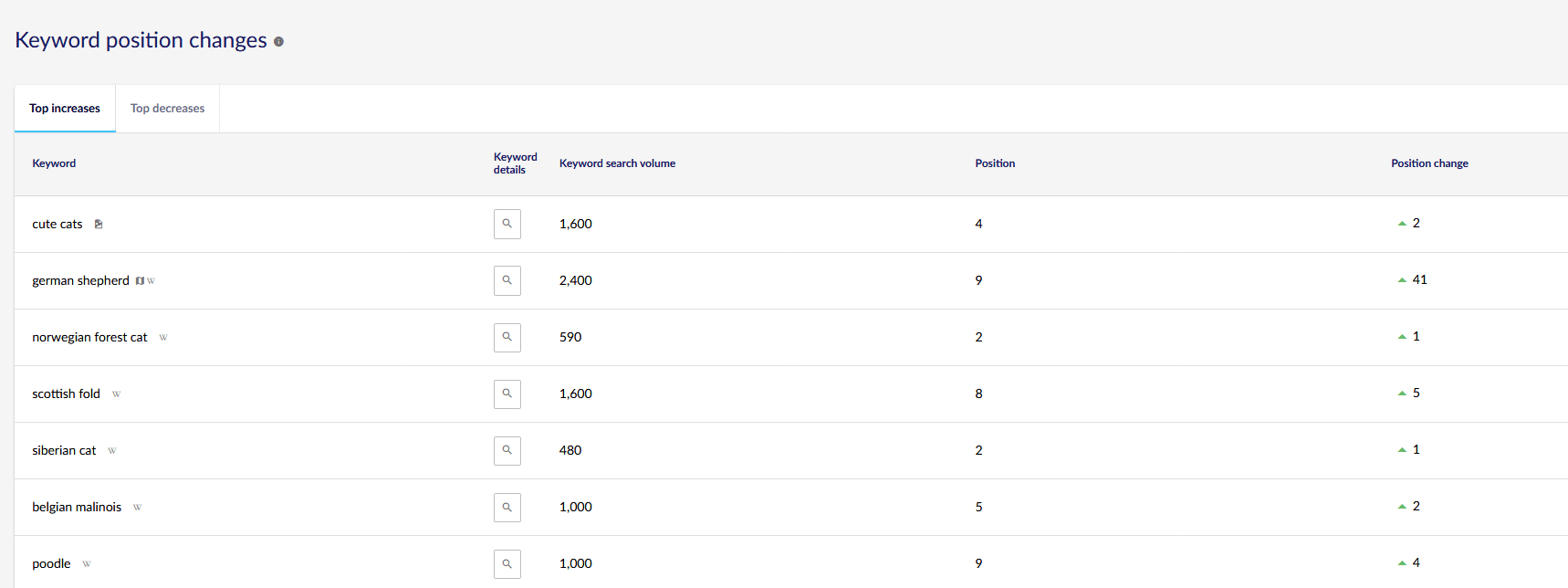
It’s also possible – and recommended – to track particular keywords, such as the quick wins described above. To do that, create a project in the Rank Tracker module. Then, enter your domain name and target keywords to receive regular updates.
Data-driven SEO – recap
Working on SEO means working with data. When discussing the use of these data for the planning and tracking your SEO campaign, we had to allow some simplifications and omissions – otherwise, this article would become a book. Let it serve you as an inspiration to take a broader look at your SEO activity. Hopefully, it will also give you an impulse to delve into your own search for data which you can then transform into tangible results. The data are plenty. Now you have a better idea of where to look, what to look for, and to what end.
 Wojciech Maroszek
Wojciech Maroszek